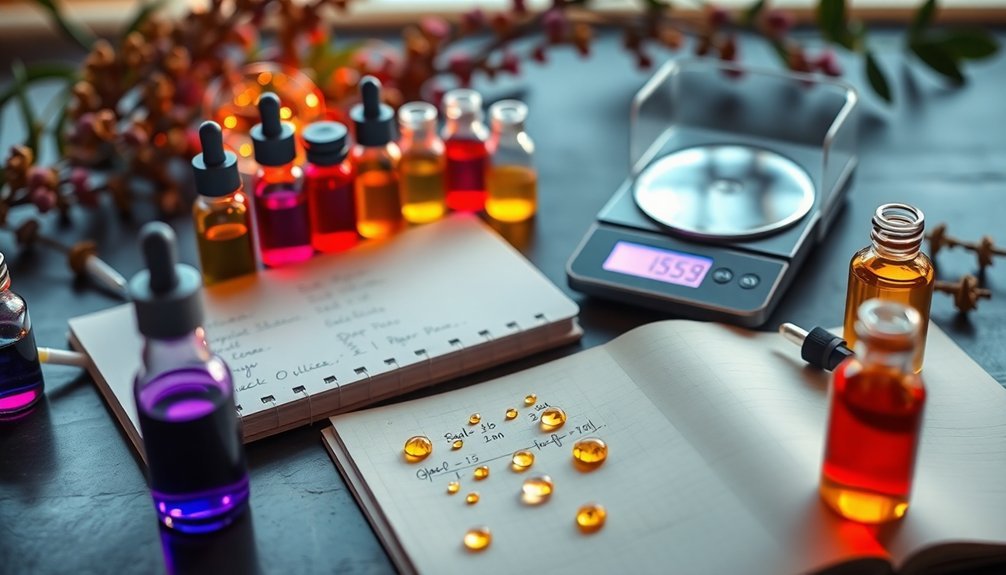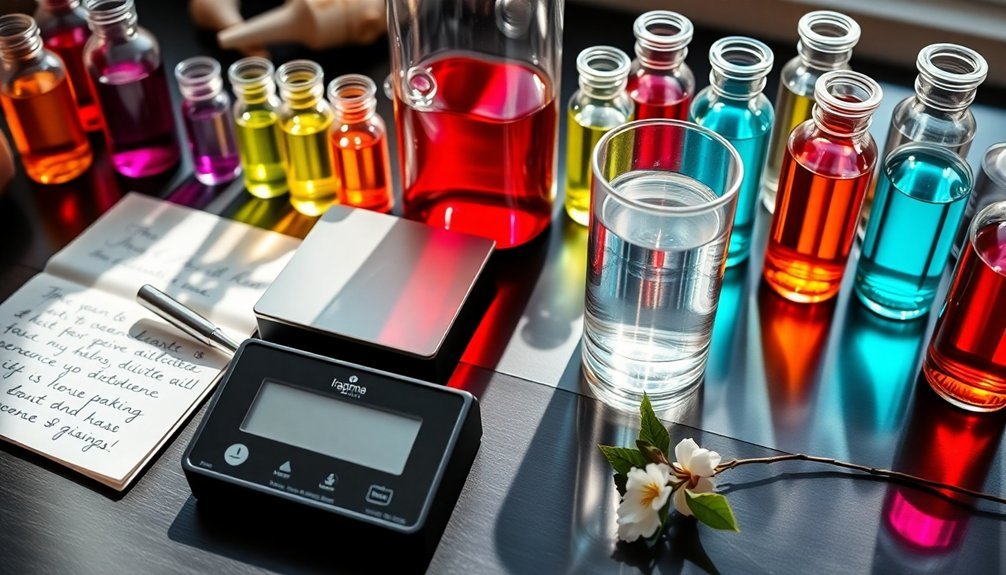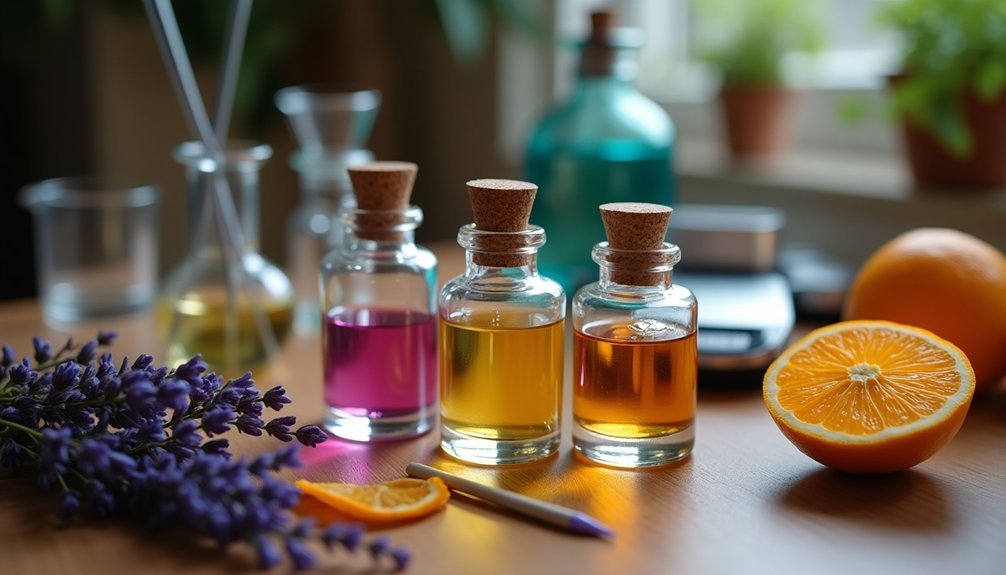You'll find three reliable perfume dilution formulas perfect for beginners: the standard 10% formula (1 part raw material to 9 parts alcohol), the gentle 1% formula (1 drop essential oil per 5ml carrier oil), and custom-strength ratios calculated by dividing 1000ml by your total parts. Start with the 10% formula for most materials, use 1% for stronger scents, and progress to custom ratios as you gain confidence. These proven formulas will build your perfume-making foundation.
Simple 10% Dilution Math: Converting Neat Materials

When creating perfume dilutions, mastering the basic 10% formula serves as your foundation for all future blending work.
You'll need to follow a simple ratio of 1 part raw material to 9 parts diluent, typically perfumer's alcohol.
To create your dilution, first zero your scale with an appropriate amber or cobalt blue bottle. For a 10% solution, you'll weigh 1 gram of your raw material, then add 9 grams of alcohol.
Remember to account for ethanol's specific gravity of 0.8 when calculating your total mixture weight. For liquid materials, use a pipette for precise measurements.
If you're working with solid or resinous materials, warm them slightly before diluting, and use a spatula for transfer. Always measure by weight rather than volume for the most accurate results. Working with diluted materials improves accuracy in your measurements compared to using raw ingredients.
The 1% Formula For Strong Scents And Essential Oils
While the 10% dilution serves as a standard baseline, certain potent materials require an even more careful approach.
The 1% dilution formula is your safest bet when working with strong essential oils, especially for facial applications or sensitive skin treatments.
You'll want to mix 1 drop of essential oil with 1 teaspoon (5 ml) of carrier oil, or 5 drops per 10 ml.
When selecting your carrier oil, opt for gentle options like jojoba, sweet almond, or coconut oil. Remember to maintain this ratio even when combining different essential oils. Using a toxicologist-tested approach helps ensure the safety of your diluted blends.
Don't skip the patch test before applying any new blend, and never use undiluted essential oils directly on your skin.
If you're pregnant, nursing, or creating blends for children, it's vital to consult a healthcare practitioner first.
Creating Custom-Strength Dilutions Using Basic Math

Learning to create custom-strength dilutions requires a solid grasp of basic math and careful attention to detail.
Start by determining your desired ratio, such as 1:10 or 1:50, then add the ratio numbers together. For a 1-liter container with a 1:10 ratio, you'll add 1+10=11, then divide 1000ml by 11 to get 90.9ml.
You'll need accurate scales to weigh your materials rather than relying on drops. Use small vials (15ml) for mixing, and clearly label each dilution. Fill your vial with perfumer's alcohol first before adding other materials.
When working with strong materials like aldehydes, you might need dilutions as low as 1%, while other materials work well at 10% to 50%.
Keep multiple dilution levels of the same material to maintain flexibility in your perfume making process.
Frequently Asked Questions
How Long Can Diluted Perfume Materials Be Stored Before They Expire?
You'll find that properly stored diluted perfume materials can last 3-4 years in cool, dark places. However, citrus-based materials expire sooner, around 18 months, while heavier molecules like musks last longer.
Should I Dilute Natural and Synthetic Materials Differently?
You'll use similar dilution methods for both natural and synthetic materials, but you should be more cautious with naturals since their potency varies. Always follow weight-to-weight ratios regardless of the material type.
Can I Remix or Adjust Dilutions if I Make Mistakes?
Yes, you can fix dilution mistakes. If it's too strong, add more carrier oil gradually. If it's too weak, you'll need to start fresh with a new batch at a higher concentration.
What Temperature Should Diluted Perfume Materials Be Stored At?
You'll want to store your diluted perfumes at a consistent room temperature (65-75°F/18-24°C) in a cool, dark place. Don't expose them to extreme temperatures or fluctuations that could alter their chemical composition.
How Can I Test if My Dilution Ratios Are Correct?
You can verify your dilution ratios by conducting a simple scent test, using GC-FID analysis if available, and double-checking your calculations. Always document your measurements to guarantee consistency in future batches.
In Summary
You'll find these three dilution formulas invaluable as you begin your perfume-making journey. Start with the basic 10% formula to get comfortable with measurements, then experiment with the 1% method for potent materials. Once you've mastered these foundations, you can confidently create custom concentrations using simple math. Remember to document your successful ratios – they'll become your personal perfume-making blueprint.





Leave a Reply